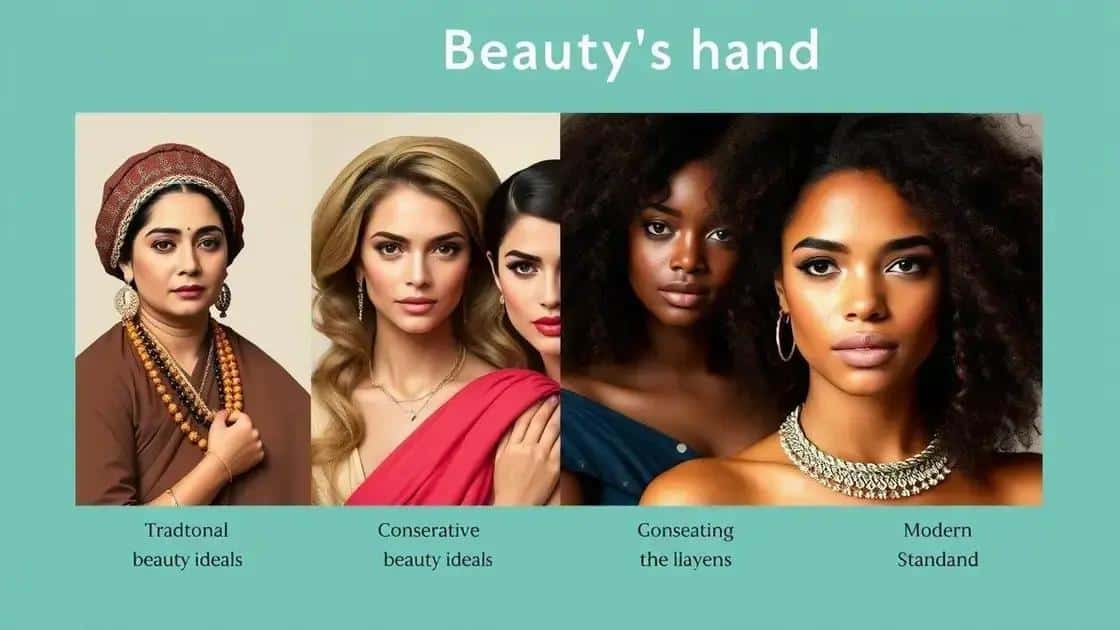Conservative era beauty standards: an inspiring overview
Conservative era beauty standards have profoundly influenced modern beauty ideals, emphasizing traditional notions of modesty and elegance while evolving to embrace diversity and individuality in contemporary society.
Conservative era beauty standards deeply influenced societal norms and personal identity. Have you ever wondered how these ideals shaped our perceptions of beauty today? Let’s dive into this fascinating topic.
The definition of conservative era beauty standards
The definition of conservative era beauty standards encompasses the ideals that dominated beauty during specific historical periods, focusing on modesty and elegance. These standards were often influenced by cultural norms and the roles women were expected to play in society.
Key Characteristics
Women were typically encouraged to embody grace and sophistication. Features such as pale skin, delicate features, and a slender figure were highly valued. This era emphasized natural beauty, often avoiding heavy makeup.
Social Implications
Moreover, beauty standards during these times reflected the broader context of social values. Women were often seen through the lens of their virtues, where physical appearance closely linked to morality. This perception created pressure to conform to these ideals.
- The ideal of modesty in clothing and behavior.
- Beauty as a reflection of social status and education.
- Influence of art and literature on beauty perceptions.
- Linking beauty standards to femininity and virtue.
Even today, the conservative era beauty standards have left a lasting legacy on modern perceptions of beauty. Understanding these historical standards helps us recognize the patterns and expectations that continue to shape our views on beauty today. By appreciating the evolution of these ideals, we can cultivate a more inclusive understanding of beauty that celebrates diversity.
Key figures and influencers in this era

The key figures and influencers in this era played a significant role in shaping beauty standards during conservative times. These individuals, from artists to socialites, impacted the way society viewed femininity and aesthetics.
Influential Women
Women such as Bette Davis and Grace Kelly set the stage for what was considered beautiful. Their styles and public personas not only defined trends but also influenced the hearts and minds of many women across the globe.
Fashion Icons
Fashion designers also contributed to these beauty standards. Coco Chanel, for example, revolutionized women’s fashion, promoting a more relaxed, yet elegant style that embraced natural beauty over excessive adornment. Designers like Chanel emphasized the importance of simplicity and elegance in clothing, helping women feel and look their best.
- Bette Davis: Iconic Hollywood actress known for her strong roles.
- Grace Kelly: Classic figure representing elegance and poise.
- Coco Chanel: Influential designer reshaping women’s fashion.
- Audrey Hepburn: Symbol of graceful beauty and style.
Additionally, artists and photographers of the time captured and perpetuated these ideals through their work. Photographers like Richard Avedon showcased beauty in a way that blurred the lines between fashion and mainstream culture. Through their lenses, they highlighted the grace and charm of women while emphasizing the interpretation of beauty defined by society.
These influential figures shaped not only the trends of their day but also left a legacy that continues to resonate in modern beauty standards. Elements of their influence can still be seen in how society appreciates beauty and the various ways it is expressed.
How beauty standards reflected societal values
The relationship between beauty standards and societal values is complex and deeply intertwined. Throughout history, the ideals of beauty have often mirrored the priorities and beliefs of the society at that time. In conservative eras, for example, beauty was closely tied to modesty, virtue, and femininity.
Beauty as a Reflection of Morality
In many cultures, beautiful women were seen as symbols of moral integrity. Society often expected women to demonstrate their worth through their appearance, which led to the belief that a woman’s beauty was directly linked to her character. This created immense pressure to adhere to specific beauty ideals.
Cultural Norms and Expectations
The prevailing beauty standards also influenced how women interacted with the world. Their appearances dictated their social status and opportunities. For example, women who conformed to the era’s modesty standards often gained respect and admiration, while those who did not could face criticism or exclusion.
- Cultural aesthetics influencing fashion choices.
- Social norms dictating beauty practices.
- The link between beauty and social privilege.
- Changing values reflected in evolving beauty standards.
Over time, these standards have evolved, reflecting shifts in societal values and technological advancements. As feminism began to rise, beauty standards started to embrace diversity, promoting a wider range of appearances. The evolution indicates a society that increasingly values individual expression over conformity.
By understanding how these beauty standards reflect societal values, we gain insight into the historical contexts that have shaped our understanding of beauty today. This awareness allows us to challenge outdated ideals and promote a more inclusive view of beauty that resonates with our diverse society.
Impact of conservative beauty ideals on modern standards

The impact of conservative beauty ideals on modern standards is profound and far-reaching. While society has evolved over the decades, echoes of these traditional ideals still resonate today in various aspects of beauty and fashion.
Legacy of Traditional Beauty
Many elements of the conservative beauty ideals have been retained in today’s beauty culture. For instance, the appreciation for natural beauty and a well-groomed appearance often traces back to earlier eras. Modern trends sometimes romanticize the elegant styles of previous generations, leading to a resurgence of vintage fashion and grooming techniques.
Societal Influence
These enduring beauty ideals continue to influence what society perceives as desirable. The increased focus on body shape and size, often dictated by fashion media, shows how past standards are reflected in current practices. Despite the push for body positivity, certain ideals still persist, showcasing the ongoing impact of conservative definitions of beauty.
- Cultural pressure to conform to specific beauty ideals.
- Fashion cycles that reflect past trends.
- Continued emphasis on modesty in some beauty standards.
- Modern reinterpretations of classic beauty styles.
Moreover, the conversations surrounding beauty have started to include more diverse perspectives, aiming to dismantle the restrictive ideals propagated by past generations. This shift challenges the notion of perfection derived from past standards and promotes a broader definition of beauty that includes various shapes, sizes, and styles.
impact of conservative beauty ideals, it becomes clear that the journey to redefine beauty is ongoing. By understanding our history, we can embrace a more inclusive approach that recognizes the beauty in diversity.
Changing perceptions: beauty then and now
Changing perceptions: beauty then and now reflect a dynamic shift in how society understands and defines beauty. Over the decades, what was once considered beautiful has undergone significant transformations, showcasing the influence of culture, technology, and activism.
Historical Beauty Ideals
Traditionally, beauty standards revolved around specific features such as pale skin, a slim figure, and modest dressing. Many historical figures like Marilyn Monroe and Audrey Hepburn embodied these ideals, becoming icons of their time. The media heavily promoted these images, solidifying them in the public consciousness.
The Role of Media
As we moved into the modern era, media began to play a pivotal role in shaping and changing these beauty ideals. Social media platforms like Instagram and TikTok now allow for a variety of voices and representations, challenging traditional standards. This evolution is significant, as it opens doors for individuals to express unique perspectives on beauty.
- Inclusion of diverse body types and appearances.
- Rise of body positivity movements.
- Influence of celebrities and influencers in shifting standards.
- Emergence of new trends focusing on authenticity.
Furthermore, beauty is increasingly recognized as subjective. With a greater emphasis on self-acceptance and individuality, the definition of beauty has broadened. It now celebrates facial and body diversity, moving beyond conventional norms. This change signifies a more inclusive approach, where everyone can find representation.
As we compare how beauty was perceived in the past to today, it becomes evident that societal values continually shape these standards. The ongoing dialogue around beauty encourages a culture that embraces differences, making the future of beauty more varied and nuanced.
The evolution of beauty standards: a continuous journey
Beauty standards have changed significantly over time, reflecting deeper societal values and cultural shifts. From rigid ideals of the past to a more inclusive view of beauty today, this transformation highlights the importance of diversity and individuality.
As we embrace different definitions of beauty, we can create an environment that celebrates every person’s unique qualities. The ongoing dialogue around beauty allows for a richer understanding of ourselves and each other.
Ultimately, recognizing and appreciating the changing perceptions of beauty can lead to a more accepting and empowered society, encouraging everyone to express their true selves.
FAQ – Frequently Asked Questions about Beauty Standards
How have beauty standards evolved over time?
Beauty standards have shifted significantly, moving from rigid ideals of the past to more inclusive representations that celebrate diversity.
What role does social media play in changing beauty perceptions?
Social media allows for diverse voices and perspectives, challenging traditional beauty norms and promoting individuality in beauty expressions.
Why is inclusivity important in today’s beauty standards?
Inclusivity fosters a culture that embraces differences, allowing everyone to feel represented and valued in their unique beauty.
How can understanding beauty standards impact society?
By recognizing and discussing beauty standards, we can promote acceptance and empowerment, encouraging individuals to express their authentic selves.





